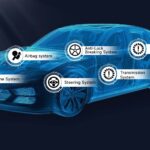Are you looking to get more out of your OBD2 Bluetooth or WiFi adapter? The standard firmware in these devices often limits their potential, leaving performance on the table. Upgrading to custom Obd2 Firmware can unlock a range of improvements, from faster communication speeds to broader vehicle compatibility. This article explores the advantages of replacement firmware for ELM327-based adapters and guides you through the process of upgrading for a superior diagnostic experience.
Why Upgrade to Custom OBD2 Firmware?
Standard ELM327 firmware is functional, but it’s not optimized for peak performance or advanced features. Custom obd2 firmware offers significant benefits, particularly for enthusiasts and professionals who demand more from their diagnostic tools. Here’s what you can expect from a firmware upgrade:
- Faster and More Stable CAN Communication: Experience quicker data transfer and a more reliable connection to your vehicle’s Controller Area Network (CAN) bus. This is crucial for real-time diagnostics and data logging.
- Expanded Protocol Support: Go beyond basic OBD2 protocols. Custom firmware often adds support for K-Line protocols (ISO9141-2, KWP2000, etc.) and specialized protocols like VAG KWP2000, KWP1281, and TP2.0 used in older Volkswagen Audi Group vehicles (pre-2012). This expanded compatibility allows you to diagnose a wider range of vehicles.
- Seamless Firmware Updates: Forget about opening your adapter for updates. Many custom firmware options include a bootloader, enabling firmware updates directly through software applications like the Deep OBD app. This simplifies maintenance and ensures you always have the latest features.
- Reduced Power Consumption: Optimized firmware can leverage sleep modes, reducing power draw from your vehicle’s battery, especially important during extended diagnostic sessions.
- ELM327 Software Compatibility: Some custom firmware is designed to be compatible with standard ELM327 commands, ensuring broad compatibility with existing OBD2 software and apps.
- Customization Options: Advanced custom firmware may offer customization, such as adjustable Bluetooth baud rates for faster wireless communication and the ability to personalize Bluetooth names and PINs for easier pairing and security.
Image depicting the top view of a Bluetooth OBD2 adapter, highlighting its compact design and electronic components.
Choosing the Right OBD2 Adapter for Firmware Upgrade
Not all OBD2 adapters are created equal when it comes to firmware upgrades. To ensure compatibility with custom obd2 firmware, you need to select an adapter based on the PIC18F25K80 microcontroller. When searching online marketplaces like Aliexpress, look for “PIC18F25K80 ELM327”.
For Bluetooth connectivity, adapters equipped with a CSR BC417 chip are highly recommended. Adapters using the BK3231 chip are also supported. These chipsets are known for their reliability and compatibility with custom Bluetooth firmware.
If you prefer a plug-and-play solution, pre-programmed adapters are available for purchase. These come with custom obd2 firmware already installed, saving you the flashing process. You can find pre-programmed Bluetooth adapters on platforms like eBay, and specialized Deep OBD OBD-II Bluetooth adapters are available for BMW vehicles, often including licenses for specific BMW coding functions.
Image showcasing the bottom view of a Bluetooth OBD2 adapter, revealing the connection pins and further electronic details.
Programming Your OBD2 Adapter with Custom Firmware
The initial programming of your PIC18F25K80 based ELM327 adapter with custom obd2 firmware typically requires a PICkit 3 programmer. This tool allows you to directly flash the microcontroller with the new firmware. Detailed instructions for flashing your ELM327 adapter with Deep OBD firmware are readily available online.
Firmware source code is usually organized by Bluetooth chip type, simplifying the selection of the correct firmware for your adapter. Common firmware directories include:
default: For standard ELM327L adapters with any Bluetooth chip (38400 baud rate).def115200: For modified adapters with a higher baud rate of 115200.bc04,hc04,esp8266,yc1021: Specific firmware versions tailored to different Bluetooth or WiFi chipsets (BK3231, BC417, ESP8266, YC1021).spp_uart,spp_uart2: Open-source Bluetooth firmware options, especially recommended for older Android car radios.
Firmware packages often include two file types: a complete firmware file (CanAdapterElm.X.production.unified.hex) which includes the bootloader, and an update file (CanAdapterElm.X.production.hex) without the bootloader. The update file is used for over-the-air updates via apps like Deep OBD. You can typically find compiled firmware files in binary release packages associated with the custom firmware project.
Using Your Upgraded OBD2 Adapter with Diagnostic Software
Once your adapter is flashed with custom obd2 firmware, you can utilize its enhanced capabilities with a variety of diagnostic software. For Windows-based diagnostics, you can use popular tools like INPA, Tool32, and ISTA-D, effectively replacing traditional OBD or ADS adapters. Setting up the connection usually involves configuring the software to communicate with your Bluetooth adapter through a virtual COM port.
For mobile diagnostics, the Deep OBD app is specifically designed to work seamlessly with this custom firmware, offering features like firmware updates and advanced diagnostic functions.
Image of the EdiabasLib Config Tool interface, displaying settings relevant to ISTA-D configuration for OBD2 adapter communication.
Factory Reset and Firmware Update Failure Recovery
Most custom obd2 firmware includes a factory reset option. This is useful for reverting settings like Bluetooth PIN (typically reset to 1234), Bluetooth name (often reset to “Deep OBD BMW”), and communication mode to default values. A factory reset is usually triggered by shorting a specific pad on the adapter’s circuit board (e.g., R26 pad to GND) during power-up.
In the event of a firmware update failure, where all LEDs on the adapter illuminate and it enters bootloader mode, recovery is often possible. By reconnecting the adapter and ignoring any error messages, you can usually retry the firmware update process through the Deep OBD app’s adapter menu.
Conclusion
Upgrading your ELM327 OBD2 adapter with custom obd2 firmware is a worthwhile endeavor for anyone seeking enhanced performance, broader vehicle compatibility, and advanced features. By choosing the right adapter, following the programming steps, and leveraging compatible diagnostic software, you can unlock the true potential of your OBD2 tool and gain a deeper understanding of your vehicle’s systems.
